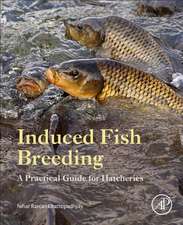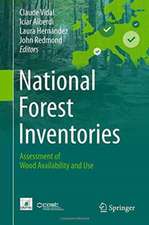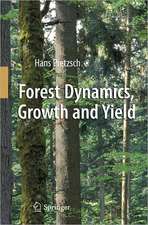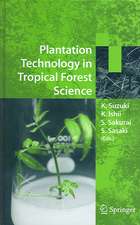Landscapes, Genomics and Transgenic Conifers: Managing Forest Ecosystems, cartea 9
Editat de Claire G. Williamsen Limba Engleză Hardback – 21 dec 2005
The goal of this volume is to provide content for public deliberations about the genetic composition of future forests. Its Section I is composed of provocative and opposing views on the question of transgenic conifer plantations. Sections II and III follow with research advances on relevant conifer genomics and ecology research, respectively. Section IV forecasts rates of technology adoption for different case studies. Finally, Section V compares the status of regulatory oversight of transgenic forest trees between Canada and the United States.
| Toate formatele și edițiile | Preț | Express |
|---|---|---|
| Paperback (1) | 1108.51 lei 6-8 săpt. | |
| SPRINGER NETHERLANDS – 25 noi 2010 | 1108.51 lei 6-8 săpt. | |
| Hardback (1) | 899.84 lei 38-44 zile | |
| SPRINGER NETHERLANDS – 21 dec 2005 | 899.84 lei 38-44 zile |
Din seria Managing Forest Ecosystems
- 18%
 Preț: 945.79 lei
Preț: 945.79 lei - 18%
 Preț: 1394.03 lei
Preț: 1394.03 lei -
 Preț: 367.69 lei
Preț: 367.69 lei - 18%
 Preț: 1113.71 lei
Preț: 1113.71 lei - 15%
 Preț: 642.21 lei
Preț: 642.21 lei -
 Preț: 431.74 lei
Preț: 431.74 lei - 24%
 Preț: 1042.44 lei
Preț: 1042.44 lei - 15%
 Preț: 711.21 lei
Preț: 711.21 lei - 24%
 Preț: 787.54 lei
Preț: 787.54 lei - 15%
 Preț: 646.62 lei
Preț: 646.62 lei - 15%
 Preț: 645.60 lei
Preț: 645.60 lei - 18%
 Preț: 1242.03 lei
Preț: 1242.03 lei - 15%
 Preț: 648.24 lei
Preț: 648.24 lei - 15%
 Preț: 693.90 lei
Preț: 693.90 lei - 24%
 Preț: 799.28 lei
Preț: 799.28 lei - 18%
 Preț: 1229.10 lei
Preț: 1229.10 lei - 18%
 Preț: 943.43 lei
Preț: 943.43 lei - 18%
 Preț: 948.92 lei
Preț: 948.92 lei - 24%
 Preț: 778.95 lei
Preț: 778.95 lei - 18%
 Preț: 945.62 lei
Preț: 945.62 lei - 18%
 Preț: 943.88 lei
Preț: 943.88 lei - 18%
 Preț: 1544.00 lei
Preț: 1544.00 lei - 18%
 Preț: 946.55 lei
Preț: 946.55 lei - 18%
 Preț: 1244.71 lei
Preț: 1244.71 lei - 18%
 Preț: 949.73 lei
Preț: 949.73 lei - 18%
 Preț: 967.08 lei
Preț: 967.08 lei - 24%
 Preț: 849.91 lei
Preț: 849.91 lei - 24%
 Preț: 903.02 lei
Preț: 903.02 lei - 18%
 Preț: 952.26 lei
Preț: 952.26 lei - 20%
 Preț: 592.63 lei
Preț: 592.63 lei
Preț: 899.84 lei
Preț vechi: 1184.00 lei
-24% Nou
Puncte Express: 1350
Preț estimativ în valută:
172.18€ • 187.62$ • 145.09£
172.18€ • 187.62$ • 145.09£
Carte tipărită la comandă
Livrare economică 19-25 aprilie
Preluare comenzi: 021 569.72.76
Specificații
ISBN-13: 9781402038686
ISBN-10: 1402038682
Pagini: 272
Ilustrații: VIII, 262 p.
Dimensiuni: 170 x 250 x 22 mm
Ediția:2006
Editura: SPRINGER NETHERLANDS
Colecția Springer
Seria Managing Forest Ecosystems
Locul publicării:Dordrecht, Netherlands
ISBN-10: 1402038682
Pagini: 272
Ilustrații: VIII, 262 p.
Dimensiuni: 170 x 250 x 22 mm
Ediția:2006
Editura: SPRINGER NETHERLANDS
Colecția Springer
Seria Managing Forest Ecosystems
Locul publicării:Dordrecht, Netherlands
Public țintă
ResearchCuprins
Pros and cons for Transgenic Conifer Plantations.- Foresters and DNA.- The Question of Commercializing Transgenic Conifers.- It’s Just A Crop: Public Perception and Transgenic Trees.- Genomics Methods, Resources and Alternative Applications.- Genomics Resources for Conifers.- A New Direction for Conifer Genomics.- Using Genomics to Study Evolutionary Origins of See ds.- Metabolic Profiling for Transgenic Forest Tre es.- Viewing Transgenic Conifer Plantations on a Landscape Scale.- Dispersal of Transgenic Conifer Pollen.- Gene Flow in Conifers.- Pines as Invasive Aliens: Outlook on Transgenic Pine Plantations in the Southern Hemisphere.- Economics of Transgenic Technology Adoption.- Economic Prospects and Policy Framework of Forest Biotechnology for the Southern U.S.A. and South America.- Private Forests and Transgenic Forest Trees.- Government Regulations and Biosafety.- Canada’s Regulatory Approach.- Biosafety of Transgenic Trees in the United States.
Textul de pe ultima copertă
What is the future of genetically modified (or transgenic) conifer plantations? The content of this edited volume Landscapes, Genomics and Transgenic Conifers addresses this question directly - and indirectly - using language drawn from policy, forest history, genomics, metabolism, pollen dispersal and gene flow, landscape ecology, evolution, economics, technology transfer and regulatory oversight. Although the book takes its title from a Nicholas School Leadership forum held November 17-19, 2004 at Duke University, its de novo contents move past the forum’s deliberations. The result is a trans-disciplinary book composed of 14 chapters written by a total of 31 authors working in North America, South America, Europe and Africa.
The book is written for policy experts, life scientists, government and business leaders, biotechnology writers and activists. Few decision-makers realize the unprecedented degree to which transgenic technology is now possible for forests on a commercial scale. Only a handful of the 550 living conifer species used for commodity value and even fewer species are being developed for transgenic plantations. Transgenic field trials started within the last decade but no transgenic pine plantations exist in 2005. But emergence of transgenic forest trees is still so recent that dialogue about the pros and cons is confined to the scientific community. And dialogue must move out into the public domain.
The goal of this volume is to provide content for public deliberations about the genetic composition of future forests. Its Section I is composed of provocative and opposing views on the question of transgenic conifer plantations. Sections II and III follow with research advances on relevant conifer genomics and ecology research, respectively. Section IV forecasts rates of technology adoption for different case studies. Finally, Section V compares the status of regulatory oversight oftransgenic forest trees between Canada and the United States. But will the book fulfil its goal? The burden of the answer lies with its readers. Will readers act – or will transgenic forests be seen as too remote or simply too rural to bother with the angst of public deliberation?
The book is written for policy experts, life scientists, government and business leaders, biotechnology writers and activists. Few decision-makers realize the unprecedented degree to which transgenic technology is now possible for forests on a commercial scale. Only a handful of the 550 living conifer species used for commodity value and even fewer species are being developed for transgenic plantations. Transgenic field trials started within the last decade but no transgenic pine plantations exist in 2005. But emergence of transgenic forest trees is still so recent that dialogue about the pros and cons is confined to the scientific community. And dialogue must move out into the public domain.
The goal of this volume is to provide content for public deliberations about the genetic composition of future forests. Its Section I is composed of provocative and opposing views on the question of transgenic conifer plantations. Sections II and III follow with research advances on relevant conifer genomics and ecology research, respectively. Section IV forecasts rates of technology adoption for different case studies. Finally, Section V compares the status of regulatory oversight oftransgenic forest trees between Canada and the United States. But will the book fulfil its goal? The burden of the answer lies with its readers. Will readers act – or will transgenic forests be seen as too remote or simply too rural to bother with the angst of public deliberation?
Caracteristici
This book shows that genetically engineered forest trees are now feasible on a commercial scale First book to lay out pros and cons on the genetically engineered conifer forests to a broader audience looking at the question from different disciplines It was written for decision-making in private and public sectors by authors from 7 countries offering controversial statements about the future of this technnology


















